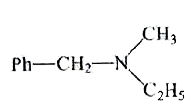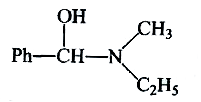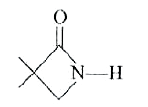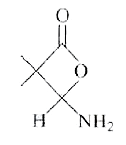The end product (B) of the reaction sequence :
C2H5−N−CH3Ph−O∣∣C−CI−−−−−−−→NaOHALiAIH4−−−−−−→H2OB




The correct Answer is:B
To solve the given problem, we will break down the reaction sequence step by step.
Step 1: Identify the Reactants
The starting compound is an amine, specifically ethyl methyl amine, which can be represented as:
C2H5−N−CH3
Step 2: Reaction with Phosgene
The first reaction involves the amine reacting with phosgene (which is represented as Ph−C(=O)Cl) in the presence of sodium hydroxide (NaOH). This reaction leads to the formation of a carbamate.
The reaction can be represented as:
C2H5−N−CH3+Ph−C(=O)ClNaOH−−−−→Ph−C(=O)−N(C2H5)(CH3)
This product is a carbamate derivative, which we will denote as compound A.
Step 3: Reduction with Lithium Aluminium Hydride
Next, compound A undergoes reduction with lithium aluminium hydride (LiAlH4) in the presence of water (H2O). Lithium aluminium hydride is a strong reducing agent that can reduce the carbonyl group (C=O) of the carbamate to an alcohol.
The reaction can be represented as:
Ph−C(=O)−N(C2H5)(CH3)+LiAlH4H2O−−→Ph−C(OH)−N(C2H5)(CH3)
Step 4: Identify the Final Product
The final product B is thus:
Ph−C(OH)−N(C2H5)(CH3)
Conclusion
The end product B of the reaction sequence is:
Ph−C(OH)−N(C2H5)(CH3)
The starting compound is an amine, specifically ethyl methyl amine, which can be represented as:
C2H5−N−CH3
The first reaction involves the amine reacting with phosgene (which is represented as Ph−C(=O)Cl) in the presence of sodium hydroxide (NaOH). This reaction leads to the formation of a carbamate.
C2H5−N−CH3+Ph−C(=O)ClNaOH−−−−→Ph−C(=O)−N(C2H5)(CH3)
Next, compound A undergoes reduction with lithium aluminium hydride (LiAlH4) in the presence of water (H2O). Lithium aluminium hydride is a strong reducing agent that can reduce the carbonyl group (C=O) of the carbamate to an alcohol.
Ph−C(=O)−N(C2H5)(CH3)+LiAlH4H2O−−→Ph−C(OH)−N(C2H5)(CH3)
The final product B is thus:
Ph−C(OH)−N(C2H5)(CH3)
The end product B of the reaction sequence is:
Ph−C(OH)−N(C2H5)(CH3)
Similar Questions
Knowledge Check
The IUPAC name of CH3−CH2C∣C2H5−O∣∣C−OCH3 is :
AMethyl 2-ethylbutanoateB1-methoxy-2-ethylbutanoneC3-MethoxycarbonylpentaneD1-methoxy-2-ethylbutanalThe IUPAC name ofCH3−OH∣C∣H−CH2−O∣∣C−CH3 is
A2-Hydroxypentan-4-oneB4-Hydroxypentan-2-oneC4-oxopentan-2-olD2-oxopentan-4-olConsider the following sequence of reactions :
HO−O∣∣C−CH3∣C∣CH3−C≡N200∘C−−−→ALiAIH4−−−−−−→H2OB, (B) isA B
B CHO−H2C−CH3∣C∣CH3−CH2−NH2D
CHO−H2C−CH3∣C∣CH3−CH2−NH2D
The major product of the following reaction is :
C6H5CH2−CH3∣C∣Br=CH2−CH3C2H5ONa−−−−−→C2H5OH
View SolutionThe major product of the following reaction is :
C6H5CH2−CH3∣C∣Br−CH2−CH3C2H5ONa−−−−−→C2H5OH
View SolutionMajor product of the given reaction is
CH3−CH3∣C∣CH3−CH∣CI−CH3C2H5O−−−−−−→
View SolutionProduct C in the reaction
C2H5BrNaOH−−−−−→(aqueous)ANa−−→BCH3I−−→C will be
View SolutionThe end product in the reaction is :
CH3CONH2P2O5−−→BH2,Ni−−−→CHNO2−−−→DCu−−−−−→300∘E
View Solution
